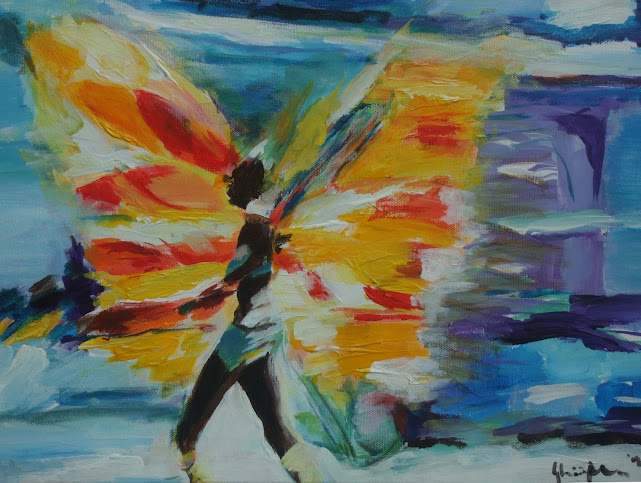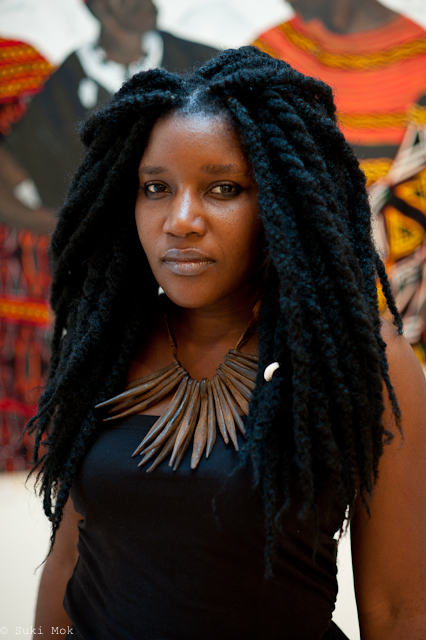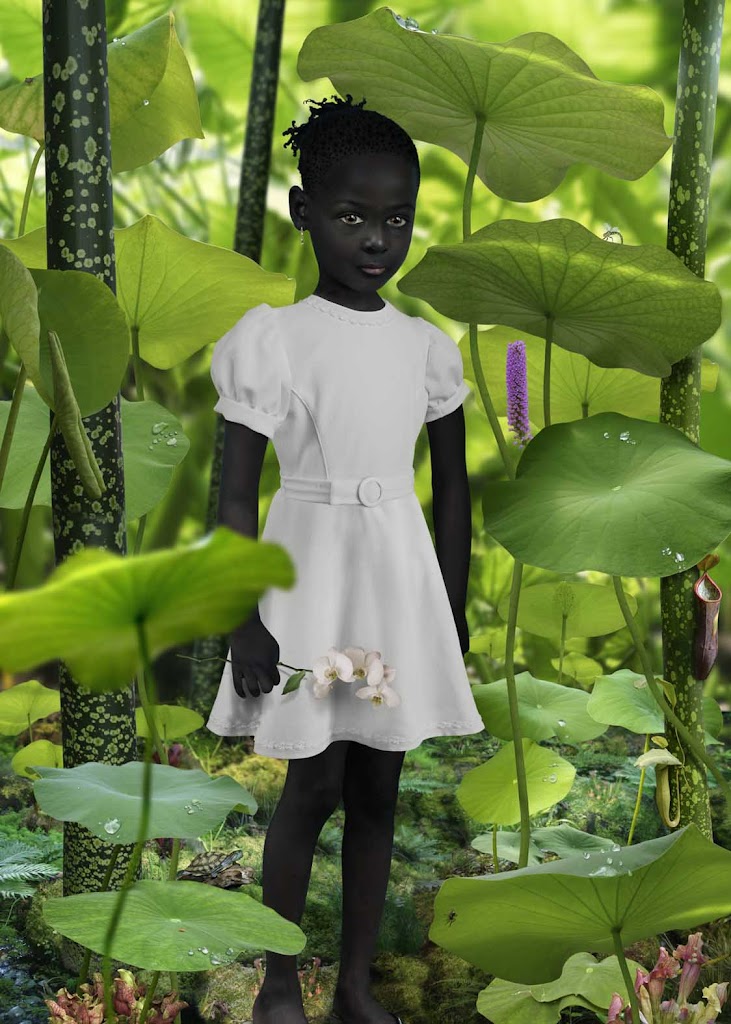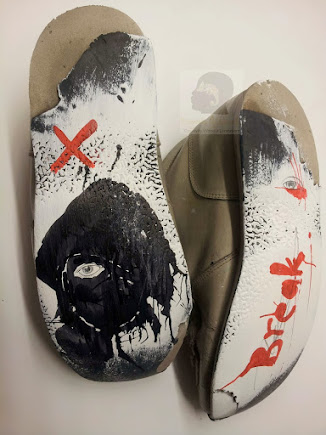
Adelaide Damoah in Conversation with Shiri Achu
Beauty, confidence, exuberance, intelligence and tenacity. These are just a few adjectives I would use to describe this talented artist. Born in the Cameroon, West Africa, Achu came to the Uk at the age of nine. An inquisitive and creative child, Achu used found materials to start to make art. Gaining A grades at both GCSE and A level art, Achu decided not to follow the path of art education that her mother wanted for her and went on to study and qualify in architecture. Achu went on to work in the field of architecture until the economy collapsed in 2008 when she was made redundant. Just before that time, Achu had been considering what to do because of the fact that her husband lived in the United States. Achu’s first exhibition entitled the “30th Act,” took place in April of 2009, coinciding with her 30th birthday. Achu’s exhibitions and exposure have been spiraling ever since.
 |
| Shiri Achu. Photo by Suki Mok |
Having only been active for three years, Achu has achieved rather a lot. With more than 20 exhibitions under her belt, I was very interested to find out about her views regarding success in the art world, specifically from the perspective of a black female artist trying to gain recognition from a patriarchal predominantly white, middle class establishment.
Adelaide Damoah (AD): Are you doing art full time?
Shiri Achu (SA): Yes, but I also have private architecture work. I have private architecture contacts that I am working on in Ghana and Cameroon.
AD: Excellent! Are you planning on pursuing the two career paths simultaneously?
SA: Yes. I aim never to sleep! The thing is, I have always wanted to be both an artist and an architect. Right now, the ratio is roughly 70 per cent art and 30 per cent architecture.
AD: From what I have seen, you have managed to be involved in a large number of exhibitions in the three years since you started out as an artist. Are any of those shows that you have organised yourself?
SA: Yes, I have done three solo shows. I organised two myself and was sponsored for the exhibition in Cameroon.
| Masai Tone (20090. Acrylic on canvas board. |
AD: Did you manage to sell any work at those shows?
SA: I did. The first show I sold about 13. That was my forst show, I was so excited! The second one in Cameroon, I sold about four. The last show I had at the Tabernacle in Notting Hill, I sold about 13 prints. All of those figures were for opening nights.
AD: Wow, that is really very impressive! Does the concept of money and sales come into your definition of what it means to be a successful artist?
SA: Not necessarily. For me, it is more about people recognising my work. Let me give you an example, a friend of mine who lives in Australia has recently become my representative over there. Once she told me that she mentioned my work to somebody and they knew who I was. I said, “What?” I was in shock! I did not realise my work had affected people as far afield as Australia. That was really cool. I think it is about more people recognising my work and what I am doing. It is about people seeing that what I am doing is important. Of course, the money comes with it but I have never really been a money person, otherwise I would never have done architecture. I am all about making a difference somehow with beautiful buildings or through the art, educating people about Africa in my own way. One of the reasons why I paint what I paint is because I want to bring African culture to the Western world and educate about our culture. I like the fact that people can, having seen a visual, know a little bit about African culture. For me, that is more success than just having money. But of course, money is important, which is one of the reasons why I introduced prints of my work. With prints, your work can be taken world wide very easily. If someone calls me from Singapore asking for a print, I send a print.
| Distant Butterfly (2009). Acrlic on canvas board |
AD: Are you concerned with gaining recognition from and being accepted by the patriarchal world that is the art establishment or are you more concerned with creating your own market?
SA: I am about creating my own market, although, it would be easier if the people within the establishment were open to help. Saying that, I am not afraid of creating my own market and I am working very hard to make it succeed.
AD: Going back to your definition of what it means to be successful in art, do you consider yourself to be successful at this point in time?
SA: Not yet. I was asked this question in another interview just a week ago. This is my third interview in about a week and a half! So, it probably looks like I am quite successful because of things like that. In any case, that question came up, but the interviewer put it in a different way. She said, “When was your big break?” My response was, I have not had a big break yet. I still think I am getting there because I am lucky enough to have had exhibitions in places where people buy my work, but I don’t think I am there yet. I am not happy with where I am at the moment.
| Midnight Tradition. Acrylic on Canvas |
AD: Well that is good because that is what will provide the friction required to drive you to keep moving forward.
SA: Exactly, yes.
AD: We have established that the art world is a patriarchal one. Looking at “successful” black female artists who have been validated by the establishment, think Wangechi Mutu, Rene Cox and Sonia Boyce, what in your opinion does it take for a black female artist to be accepted and validated as successful within the art establishment? There are not very many black female artists recognised by the art establishment even though there are very many black female artists currently working.
SA: I know that Wangechi Mutu’s work has a good message. (Wangechi Mutu observes: “Females carry the marks, language and nuances of their culture more than the male. Anything that is desired or despised is always placed on the female body.”) It is a little bit controversial, it is unique and because of her style, you do not automatically assign it to the African market. I think those things may contribute to her success. Her message is unique, it is a little bit different and I have not personally experienced that kind of thing, not until I saw her work. As for the latter part of your question, it is difficult to answer because if they aren’t, then they aren’t. For me it is all about the message that they portray, why they do what they do.
AD: Yes, I think that the element of controversy seems to be important as well. It seems to be a common thread. For female artists specifically- not just black female artists, if you think of Tracey Emin, as soon as she made that bed, all of a sudden, she was news worthy and that is in part what made her name.
SA: Exactly. A few days ago, I was showing some work in London. Some really powerful art critics were there and they decided to critique one particular painting. This particular piece, I have shown once before at the Commonwealth Secretariat when I was invited to exhibit there last year. The piece is called Rose and everyone who has seen that painting loves it, which is of course why I chose to exhibit it. I have had people pre order prints of that painting prior to me even announcing that there would be prints available! I have had people commission me to do other paintings based on the exact same concept, from that painting! I had some amazing and encouraging comments and some not so good comments. The painting was of a strong black woman, a heroine. The woman is pregnant. One of the critics said he loved the concept, another one did not like the concept but loved the expression in the face of the woman. The overall impression that I got was one of confusion. One said, “you are trying to portray an African heroine?” I said yes! There were more than one of this art establishment critics critiquing and examining my work. Although the majority of them had overwhelmingly positive responses, they all rejected my work and moved on to the next. I am very thankful that I had the opportunity to have my work critiqued by these very powerful art people and at the end of the day, who am I to argue with them? But the whole experience did say a lot to me. For me, I felt like they just could not relate to the work.
AD: Wow! Maybe they had little to no understanding of the African Aesthetic?
SA: Yes!
AD: This also perfectly illustrates what we were just talking about with regards to the art establishment accepting and validating the work of black female artists. What I find interesting is that when it comes to the art establishment accepting or not accepting certain groups of people, when enough people are doing that thing, or joining the movement and becoming successful within their own market, the art establishment suddenly sits up and takes note! Then you will be hearing people in the upper echelons saying, “Darrrrrling! This is the next big thing! Fabulous darling!” So keep doing what you are doing and that is exactly what will happen!
SA: (Laughing) Exactly! Well I want to do a major exhibition with about thirty variations of the Rose painting. I have already started and they are all quite big. I think it would be really cool.
AD: Is this an exhibition that you are organising yourself?
SA: Yes, this is for my next collection. So that piece that the critics were critiquing was the first from that series for the exhibition.
AD: What would you say is your ultimate dream for your art?
SA: I would love to have a mega exhibition. Not right away because I don’t think I am ready. Maybe in about ten years. A major retrospective showing my growth over the years. I would like for people to know me! From all the musicians, you know, so that they have a piece of Shiri Achu art in their house! Is it fame? I don’t want to walk down the street and be recognised so maybe not. You see, my art, when I do it, as much as it is to educate, is for the people here who have never been to Africa to think that after seeing my work, they would love to go and see Africa. I also want them to see Africa in a different light. I would like to make a small impact like that.
 |
| Ma Africa Pounds. Acrylic on hardboard. |
AD: I think you will! It has already started! You mentioned musicians, it only takes for one major celebrity to endorse your work for their friends and everybody else to take notice and asking them, “Where did you get that fabulous piece?”
SA: Well Faith Evans bought one of my paintings and nothing really came out of that.
AD: Yes. Maybe if you got someone like David Beckham to buy a piece?
SA: The thing is, I would not be impressed by David Beckham buying a piece for the sake of it. I would rather he bought it because he appreciates it rather than just because he thought to himself, “Shiri Achu work is supposed to be cool, I have got some money, let me just buy one.” I want people who are going to appreciate my work to own my work.
AD: This is part of the issue that a lot of artists face. When you start getting big and your work has a real market value, people start buying your work as an investment rather than because they love it. Next thing you know, the person that bought your work saying that they would cherish it forever goes and puts it up for auction!
SA: I have friends who have my work whom I have specifically told not to ever sell it. If they ever did, I would be really upset! I have told them all! It is meant to be for the person who bought it, it is meant to have value for them, so why whould they then turn around and use it as some sort of money tool? I don’t like that.
AD: But if you continue on this trajectory, it is almost inevitable that it will happen. Not necessarily someone that you know, but someone, somewhere could end up placing your work in an auction.
SA: That is fine, but if it was someone close to me, then I think that I would be hurt.
AD: I was reading something today about an artist who discovered for the first time that one of his paintings had been put up for auction. Not by somebody that he knew but by someone who had once bbought a piece at an exhibition. He said he felt hurt by it even though it is in a lot of ways a marker of success for many artists.
SA: It is a way of knowing that you are getting there isn’t it. It is a great signal to show when you are actually there. Or getting there.
AD: Exactly. Because that is a very tangible demonstration that a market for your work exists.
SA: Exactly. I agree.
| Along 2 (2010). Acrylic on Canvas Board |
AD: Imagine a young female comes to you and says that she wants to follow your path, in your footsteps and pursue her ultimate dream which is basically the same as yours. What advice would you give to her?
SA: If it is painting, whatever it is, make that work recognisable. Create a niche for yourself. Also, you have to have a passion for it. I find that if you do not have the passion, you can not do anything. I can stay up all night working because I love everything that I am doing. I love being an artist, I love being an architect. Because of my passion, I work very hard at it, because I don’t find it a chore. I don’t feel that it is work. If you are going to be a painter, I think you should find a subject matter, find what you love to paint and you paint. You have to find marketable tools. It took me a long time before I started selling prints because I was intent on just selling the originals. One day, two years ago, just as I was doing my first exhibition, I was sitting down with my girlfriends and they advised me to produce prints. At the time I said, “No way! Art is a one off piece.” They told me off! They said, “What are you talking about, that is how you will make money!” I told them not to worry about it and insisted everything would be fine. Anyway, I had the exhibition and a few small paintings were sold. I had a guest book out and people were signing the book and writing their comments. I had so many comments about particular pieces stating that they really liked them but just could not afford them. I then decided to make the prints! I started off printing onto canvas and people were still not able to afford them so I then went to fine art prints on paper. It has been a learning curve but now I make signed limited prints on paper and they still hold a certain value because they are limited edition. You see, so I learned my market. You have to know your market and understand what sells. Put yourself out there. As much as people invite me to exhibit at amazing places like the Commonwealth Secretariat or the Houses of Parliament, I really put myself out there. For Black History month, I called around asking what was going on because I wanted to exhibit somewhere. That is how I came to exhibit at Black History Live in Wembley Stadium. I paid £200 of my own money to have an exhibition stand there. I sold a few, maybe six in that weekend. But it was not about the sales. The contacts that I got were worth so much more. That is how I met the lady who invited me to exhibit at the Commonwealth Secretariat and I got paid double what I had paid to do the Wembley exhibit. You can see that it is all about putting yourself out there, looking for the opportunities and enjoying it while never letting it go to your head because people will not like you! It is so much better to remain yourself rather than thinking that you are better than anybody. If you are about educating and showing people Africa and you are reaching those goals, then you should just be happy for it because you are doing what you set out to do.
Follow Shiri Achu’s work.
Website: www.shiriachuart.com
Twitter: @shiriachuart
Friend on Facebook: https://www.facebook.com/#!/shiriachuart Fan on Facebook: https://www.facebook.com/#!/pages/SHIRI–ACHU-ART/120656047946915
Blog: http://shiriachuart.blogspot.com/
Twitter: @shiriachuart
Friend on Facebook: https://www.facebook.com/#!/
Blog: http://shiriachuart.blogspot.
An abridged version of this interview will be published in the April edition of Lime Magazine with thanks to Vernia Mengot, new editor.
Thanks to Mark M. Whelan
The latest news in contemporary and modern art in New York, London, Paris and Berlin





